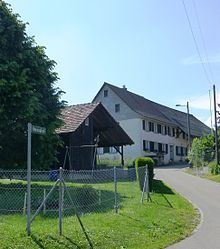 | ||
Verenahof (also known as Büttenharter Hof or Verenahöfe) was a German exclave in Switzerland, administratively part of the German town of Wiechs am Randen (which is now part of the town of Tengen). Geographically, it was separated from Wiechs am Randen by a 200–300 metre wide strip of Swiss territory.
Contents
Reload 4 live im verenahof 2 7 2010 part ii
The history of Verenahof
In 1522, Emperor Charles V and his brother, Archduke Ferdinand of Austria purchased Verenahof along with other territories in the vicinity (Tengen, Kommingen, Wiechs am Randen) from Count Christoph von Nellenburg, who expressly wished not to sell these possessions to the Swiss Canton of Schaffhausen.
In the 17th and 18th centuries there were repeated disputes between Tengen and the adjacent Schaffhausen over the access roads and the exact delimitation of the enclave. Residents of Verenahof were Catholic at that time whereas the inhabitants of Büttenhardt were Protestant. On Catholic holidays Verenahof denied the inhabitants of Büttenhardt rights of transit.
In 1806, the Grand Duchy of Baden inherited sovereign rights over Verenahof, which became an enclave within the canton of Schaffhausen. In 1815 and 1839 Swiss attempts to obtain Verenahof were unsuccessful. In 1829 a schoolhouse was built in Wiechs am Randen where the children from the Verenahof enclave could attend school. By 1855 inhabitants of Verenahof were also Protestant as were their Büttenhardter neighbors; they had become a small Protestant minority within the otherwise completely Catholic community of Wiechs am Randen.
In the 1920s, there were several attempts to integrate the Verenahof into Switzerland but the Baden Ministry of the Interior repeatedly rejected these. In the 1930s, the border markers around the exclave were updated. On 30 April 1945, four German officers sought refuge within the enclave. The Swiss police, however, expelled them.
By 1964 a treaty was concluded between Germany and Switzerland, which entered into force on 4 October 1967. The 43-hectare territory, containing three houses and fewer than a dozen people, became part of Switzerland with the transfer of 529,912 square metres (5,703,930 sq ft) of West German land parcels (that had administratively been part of the German towns of Konstanz, Öhningen, Rielasingen, Wiechs am Randen, Altenburg, Stühlingen, Weizen and Grimmelshofen) in exchange for the transfer to West Germany of an equal area of Swiss land parcels (which had administratively been part of the Swiss towns of Kreuzlingen, Hemishofen, Büttenhardt, Opfertshofen, and Merishausen). Verenahof now belongs to the Swiss municipality of Büttenhardt.
At the Wiechs am Randen town hall there are some remaining border markers that had become obsolete with the land swap in 1967; and in Büttenhardt, at the old school house, some old border markers from the 1930s have been used to frame bushes planted around the enclave.
